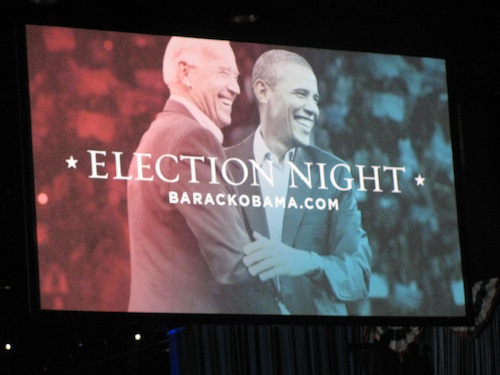
Millions of Americans breathed a sigh of relief during the early hours of Nov. 7 when it became clear that voters would send President Barack Obama back to the White House for a second term. It was the most costly election in U.S. history, and perhaps one of the most viciously fought as GOP contender Mitt Romney and the Republican Party practiced a “scorched earth” approach to politics.
Battling an unprecedented barrage of lies, voter suppression laws, racially-charged attacks and fringe ideology on women, immigrants, gays and lesbians, fueled with billions of Wall Street and secretive super PACS dollars, the coalition backing the president pulled off what was once seen as an impossible task. It reelected the first African American president to four more years amidst a sluggish – and in many cases dismal – economy that has left millions without jobs and facing mounds of personal debt.
The Republicans tried to turn the election into a referendum on Obama’s four years in office, often appealing to the most crass and base instincts of voters. But in the end, the voters seemed to agree with Obama on the election, a choice between two distinct visions. Romney and the Republicans’ vision of destroying government and creating a free-market, dog-eat-dog type of society versus Obama and the Democrats’ vision that includes a role for government in creating jobs, providing health care and balancing sacrifice and prosperity between the haves and have nots.
Given the political atmosphere, Obama’s victory is significant although the numbers show a deeply divided electorate. With Florida still out, Obama won handily in the Electoral College with 303 of the necessary 270 votes to win versus Romney’s 206. Obama won 50% to Romney’s 48% in the popular vote, a difference of some 3 million votes. If Florida goes to Obama that will mean Romney won only one of the nine battleground states – North Carolina. Obama won Nevada, Colorado, Iowa, Wisconsin, Ohio, Virginia and New Hampshire.
Obama’s winning coalition included sizeable advantages over Romney among key electoral demographics turned off by the GOP’s extreme positions on immigration, women’s rights, marriage equality and voting laws. Obama won 75% of the multi-ethnic Latino vote, which includes voters of Mexican, Cuban and Puerto Rican origin.
Union members and young voters of all races along with African American voters remained a solid, savvy and reliable base for the president and the campaign’s successful get out the vote efforts.
The gender gap climbed to 18 percent compared to 12 percent in 2008, with women preferring Obama’s positions on abortion, birth control, equal pay and the economy.
Obama gapped Romney significantly on the Asian American vote.
Drawing the class line, while crossing racial and gender lines, gave Obama and his coalition a decisive edge in Ohio, the epicenter of the Electoral College battle. Union households and working class voters preferred the president over Romney. Among white men with incomes of $75,000 or less the vote was evenly split.
In contrast, Romney held a commanding 30% edge over the president with a similar demographic in the battleground state of Virginia, Politico reported before the election.
The auto bailout and exposing Romney’s 1% Bain Capital elitism with a summer ad campaign were seen as paramount in winning Ohio’s working-class electorate for the president.
In his election night speech to a battle-tested crowd at Chicago’s McCormick Place, the president seemed visibly moved by the voters’ choice after such a tumultuous and prolonged battle, where his chances of success (and his supporters’ mood) seemed to rise and fall with every issuance of poll numbers.
He spoke about democracy and self-government applauding all who voted no matter who they backed. But on the long voter lines, the president said, “We have to fix that.”
He urged ongoing political participation. “The role of citizens in our democracy does not end with your vote. America’s never been about what can be done for us; it’s about what can be done by us together, through the hard and frustrating but necessary work of self- government,” he said.
Illustrating the power of ordinary people active in the political process, the president said that’s what motivates him and others to public service.
“That’s why we do this. That’s what politics can be. That’s why elections matter. It’s not small, it’s big. It’s important,” he said.
The battle for the interpretation of the election is underway. The Republicans maintained their control over the House of Representatives, while the Democrats gained votes in the Senate.
Wins for Senate newcomers Tammy Baldwin, Elizabeth Warren, Mazie Hirono and Heidi Heitkamp – all Democrats – along with reelection of incumbents Kirsten Gillibrand, Claire McCaskill and Maria Cantwell bring the number of women senators to an all time high of 20.
Baldwin is the first openly gay person in the Senate. Hirono is the first Asian American female senator, first Buddhist and first U.S. senator born in Japan.
Right-wing pundits and politicians eager to set their post-election agenda say the elections maintain the “status quo” and claim a mandate for severe budget cuts, tax cuts for the wealth and deregulation.
The first big battle is over the so-called “fiscal cliff,” which Wall Street and their congressional cohorts see as an opportunity to push their plan for Social Security and Medicare “reform.”
Photo: (PW/Teresa Albano)
Corrections were made to this article regarding the number of women in the Senate and the battleground states the president won. 11/8










